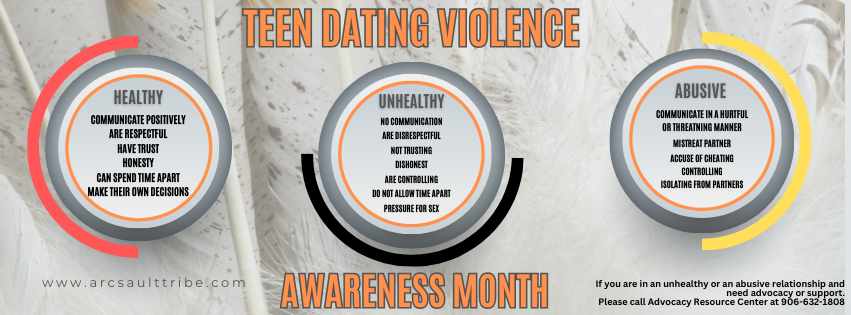February Teen Dating Violence

February is Teen Dating Violence Awareness Month
February is typically associated with love and relationships. We often find our “first love” or experience “puppy love” during adolescence. During these formative years, teenagers also begin to demonstrate behaviors they have learned from the adults in their lives as they seek romantic relationships. It is imperative for adults to help guide our youth and to set positive examples for them as they travel down the road to adulthood. Being a positive role model and educating about unhealthy relationship behaviors for our youth can significantly reduce some of the factors that lead to Teen Dating Violence.
Teen Dating Violence is defined as “the physical, sexual, or psychological/ emotional abuse within a dating relationship among adolescents.” Dating or domestic violence stems from the desire to gain power and control over the intimate partner. Teens in unhealthy relationships may not immediately recognize the signs or behaviors that are indicative of dating violence. Often, teens confuse these unhealthy behaviors with feelings of love and adoration. A young girl may feel that her boyfriend loves her so much because he always wants her with him or prevents her from hanging out with her friends, when, in fact, this is controlling and jealous behavior.
Parents, grandparents, aunties, uncles, guardians, and friends must have frequent (sometimes uncomfortable) conversations with teens when a red flag is raised. Having these real and in-depth conversations with teens establishes the lines of communication and lets them know they can come to you for advice, vent, or ask for help. Teens need to acquire the skills for setting relationship boundaries, understanding consent regarding sex and intimacy, managing feelings appropriately, healthy communication, and having appropriate expectations of others. Maintaining the lines of communication by talking often will not only help with guidance but will let teens know they can come to you before something happens and possibly prevent future abuse.
It is not always easy for teens to express their feelings to adults, but knowing they have someone willing to listen is vital. According to ihs.gov (Indian Health Services), it is reported that 1 in 3 adolescents in the United States is a victim of physical, sexual, emotional, or verbal abuse from a dating partner. For Native American teens, the rate is even higher. In one study by the Center for Disease Control, the rate of teen dating violence rate among high school students in Alaska’s Native communities is 13.3%, nearly 4% higher than the national average of 9.8%. Further studies suggest that American Indians are 2.5 times more likely to experience sexual assault crimes compared to all other races, and one in three Indian women reports having been raped during her lifetime” (from The National Council of Juvenile and Family Court Judges).
The numbers for Teen Dating Violence continue to climb each year. Violence, including self-inflicted injuries, homicide, and suicide, account for 75% of Native youth deaths, according to the U.S. Attorney General’s 2014 study. Lastly, students who identify with the LGBTQ community experience a higher rate of dating violence than those who identify as straight, according to the Centers for Disease Control.
So, what does teen dating violence look like? Some signs include but are not limited to: Physical Abuse: Hitting, punching, shoving, restraining, biting, scratching, hair pulling, pinching, or anything that causes harm to another person.
Sexual Abuse: Pressuring or forcing a partner to engage in unwanted sexual activity, using social media or text messages to pressure partners to share photos, raping or coercing a partner to perform sexual acts, preventing the use of birth control or other forms of contraception.
Verbal Abuse: Name calling, yelling, insulting, embarrassing, criticizing, etc.
Psychological Abuse: Using threats and intimidation, such as threatening to end the relationship, threats to cause harm to themselves or others, threats to commit suicide, or to cause harm to pets or property. Using controlling tactics such as not allowing their partners to see friends or family or preventing them from going places, controlling what clothes are worn, extreme jealousy, spreading rumors, minimizing behaviors, or blaming their partners for their abusive actions.
Using Technology: Excessive texting, messaging, or calling; cyberbullying; checking partner’s phone without permission; using location services to track partner, stalking; creating fake profiles to spy on a partner; posting on partner's social media; messaging others about a partner; etc.
Teen dating violence can have short and long-lasting adverse effects on teens. Teens may experience depression and anxiety during or after the relationship. Teens may turn to abusive behaviors such as drugs and alcohol as a result of their relationship, or the abusive partner may have turned them on to addictive substances during the relationship.
Youth may also perform antisocial behaviors such as lying, cheating, theft, bullying, or violent acts towards others. Depression and thoughts of suicide become significant concerns for teens experiencing intimate partner violence. Teen abusers may carry their abusive behaviors into adult relationships. Teens who are victims of TDV may also become victims of IPV later in life.
If you find yourself in an abusive relationship or feel you are being treated inappropriately, please tell someone and consider ending the relationship. If your partner is making you uncomfortable or forcing or coercing you to do things you disagree with, know you are not alone. There is help.
The Advocacy Resource Center resources to assist with teen dating violence and provide care and counseling to those in need. Call 906-632-1808 to speak to an advocate. For more information, visit the Advocacy Resource Center’s website at www.arcsaulttribe.com